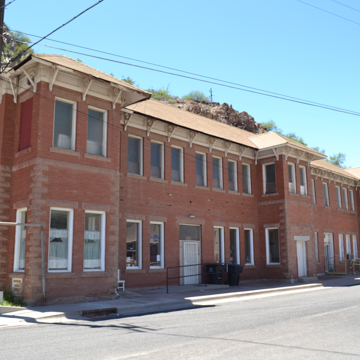You are here
Arizona Copper Company Offices
The Arizona Copper Company (ACC) selected a site at the base of a cliff near its smelting operations to erect a two-story headquarters and office building. Facing the town’s main thoroughfare, the building helped define the west edge of a de facto plaza, bounded by the ACC’s community library to the north, the San Francisco River and bridge to the east, and the Arizona and New Mexico Railway’s yard and depot to the south. The cornerstone was laid June 5, 1904, with great fanfare and a bit of trowel-work by ACC President James Colquhoun, who was regarded as a town father.
The ACC’s Superintendent of Construction, Emil Schumann, designed the building, which is best described as a territorial version of the Renaissance Revival style. In its original configuration, the building was an elongated rectangle with projecting pavilions at each end. This profile allowed for the incorporation of operable windows in opposing elevations providing for maximum penetration of natural light and breezes. A 1910 addition to the south housed the railway (an ACC subsidiary) offices and matched the original in height, detailing, and materials, increasing the length of the rectangle and adding another forward bay, producing a symmetrical street front elevation as a result. A partial veranda with ornate turned wooden posts and balusters once graced this facade, but it has long since been removed. The walls are brick with sandstone quoins, lintels, sills, and belt courses. The hipped roof, now covered in asphalt shingles, was likely originally slate shingles or wood shakes. Gabled dormers added detail and decorative brackets supported the eaves.
After Phelps Dodge (PD) acquired the ACC holdings, the railway was transferred to PD’s own El Paso and Southwestern system. No longer needing offices in Clifton, PD leased the railroad portion of the building to the Gila Valley Bank and Trust Company for use as one of that institution’s first two branches. Within months, the Solomonville–headquartered bank (in Graham County) merged with Valley Bank of Phoenix and become the Valley National Bank. The Clifton branch operated continuously in this location into the 1980s. PD also leased space in the building to the Benevolent and Protective Order of Elks (BPOE), Lodge #1174. Around 1970, the Elks built a modern addition to the north side of building. It was designed by architect Joe Wong, a Clifton native and descendant of the town’s once-thriving community of Chinese immigrant laborers and business proprietors.
In 1983 the protracted strike against PD coupled with extensive flooding the same year, adversely effected businesses in the former ACC office building. The Valley National Bank shut its branch in 1985, after a landslide damaged the building. The Elks in Clifton also went into decline, eventually merging with the lodge in the Safford. Since then, the building has housed a variety of other uses, including the Greenlee County Alternative School. Although the original double-hung windows have all been replaced with fixed glazing, the structure retains a high degree of integrity. The building was listed in the National Register of Historic Places in 1990 as a contributor to the Clifton Townsite Historic District.
References
Ryden Architects, Inc. Clifton Townsite Historic American Buildings Survey, Vol. 2. U.S. Army Corps of Engineers, 1995.
Zindel, Udo. Landscape Evolution in the Clifton-Morenci Mining District, Arizona, 1872-1986.Master’s thesis, Arizona State University, 1987.
Writing Credits
If SAH Archipedia has been useful to you, please consider supporting it.
SAH Archipedia tells the story of the United States through its buildings, landscapes, and cities. This freely available resource empowers the public with authoritative knowledge that deepens their understanding and appreciation of the built environment. But the Society of Architectural Historians, which created SAH Archipedia with University of Virginia Press, needs your support to maintain the high-caliber research, writing, photography, cartography, editing, design, and programming that make SAH Archipedia a trusted online resource available to all who value the history of place, heritage tourism, and learning.






